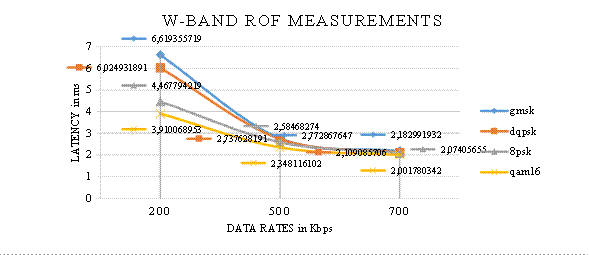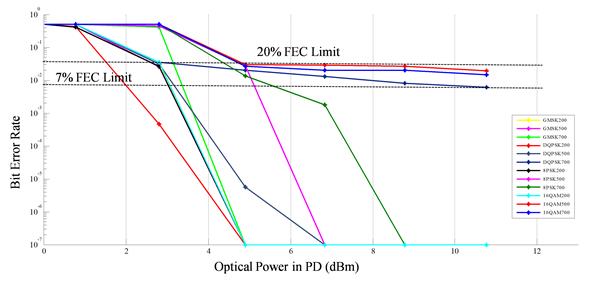1. Introduction
Real time reaction capabilities of new technologies will enhance the way of communicating and will enable an unpredictable plurality of new applications, products, and services [1]. Likewise low latencies are a must-have in real time applications which consider the time of iteration between the senses of the human body and machines [2]. In the same way 5G wireless networks and new concepts such as Tactile Internet and Haptic Internet, which are the evolution of Internet of Things (IoT), require significantly lower round trip delay times in the range of one millisecond [3].
Hybrid fiber-wireless millimeter-wave (mmWave) systems are a promising technology to cope with the next generation of 5G wireless networks capacity and latency requirements [4].
Moreover, mmWave systems have some advantages such a wide bandwidth available (30-300 GHz) and no interference with current radio services. Some authors have demonstrated the capacities of millimeter wave links. For instance in [5], a single side-band 60 Gbit/s transmission at W-band by means of the multi-band approach of carrierless amplitude phase (MultiCAP) is presented. Likewise, in [6] a fiber-wireless system at W-band that delivers multichannel 120-Gb/s data through 80-km fiber and 2-m 2×2 multiple-input multiple-output (MIMO) wireless link adopting polarization division multiplexing and quadrature phase shift keying (PDM-QPSK) modulation is described.
As far as latency is concerned, it consist of four components: propagation time, transmission time, queuing time and processing delay [7]. End-to-end latency is the sum of all these four components. It is important to mention that there are no procedures documented in the state of the art to measure latency in a laboratory experiment in real time.
In terms of latency, some works [8,9], described comparisons or improvements in mobile networks, such as High Speed Packet Access (HSPA), 3G and Long Term Evolution (LTE). The results showed that optimizations of the LTE scheduling, resource allocation policies and Time Transmit Intervals (TTI) reduction, have improved the latency substantially. For example, TTI in EDGE is 20 ms, Wideband Code Division Multiple Access (WCDMA) brings TTI to 10 ms, while in High-Speed Downlink Packet Access (HSDPA) it is brought to 2 ms. The authors in [10] described one of the critical parameter for the latency. They exposed that the remaining time for round trip time propagation between the Remote Radio Head (RRH) and the Base Band Unit (BBU) is only 700 μs for LTE and 400 μs for LTE-Advanced. When applications are shown, other authors explained that LTE reduces the latency from call setup to idle latency in approx. 360 ms compared with an HSPA system, where signaling is carried on HSPA channels [11]. In [12], authors achieved 1.2 ms time of latency. Other researchers have already worked on how to achieve low latency. For instance in [13], authors showed that they can achieve short TDD latency with physical round trip time (RTT) in the order of < 1.5 ms, including synchronization, scheduling signaling and actual data transmission with acknowledgement. Meanwhile, other researchers affirmed that if a Generalized Frequency Division Multiplexing (GFDM) is well configured by LTE, the latency can be reduced in a factor of fifteen. They also explained that when a GFDM configuration is proposed to allow the coexistence of 5G and 4G signals, the latency of the 5G signaling can be 10 times smaller than in the current LTE system [14].
In this paper, real-time experimental measurements of latency are presented for a W-Band fiber-wireless link using software defined radio. Three important analysis were made. First, it was described a GNU Radio scenario to make the latency analysis. Subsequently, the experimental setup was explained. Back to Back and over W-Band Radio-over-Fiber measurements for different modulation schemes as Gaussian Minimum Shift Keying, Differential Quadrature Phase Shift Keying, 8 Phase Shift Keying, Quadrature Amplitude Modulation 16 (GMSK, DQPSK, 8PSK, QAM16), with three different data rates, were considered. Finally, the bit error rates (BER) were analyzed in order to evaluate the reliability of the system.
2. Software defined radio
This section describes the SDR implementation in a real time radio over fiber link to measure latency along with the design parameters used for transmission and reception. GNU Radio is an open source Software Defined Radio SDR framework, for designing Digital signal processing (DSP) radio systems on a software basis [15]. Its structure consists of a python-based Graphic User Interface (GUI) with connected processing blocks that perform operations on the signals and create flow graphs.
GNU Radio works with devices called Universal Software Radio Peripheral (USRP) developed by Ettus Research. In our work, we used the USRP model N210. USRP N210 that consists of a motherboard with Xilinx Spartan XC3SD3400A FPGA and 2 pairs of DACs and ADCs. In addition, this model has a WBX daughterboard. The WBX daughterboard is a transceiver with frequency range from 50 MHz to 2.2 GHz [16]. The connection to the PC is done through an Ethernet interface.
Figure 1 shows the block diagram was used in GNU Radio in order to measure latency. Basically, a PRBS7 data file is sent to a packet encoder block repetitively. The packet encoder makes 64 bytes packets and sends the frame to the modulation block. We use different blocks to modulate the Radio Frequency (RF) signal such as GMSK, DQPSK, 8PSK, QAM16.
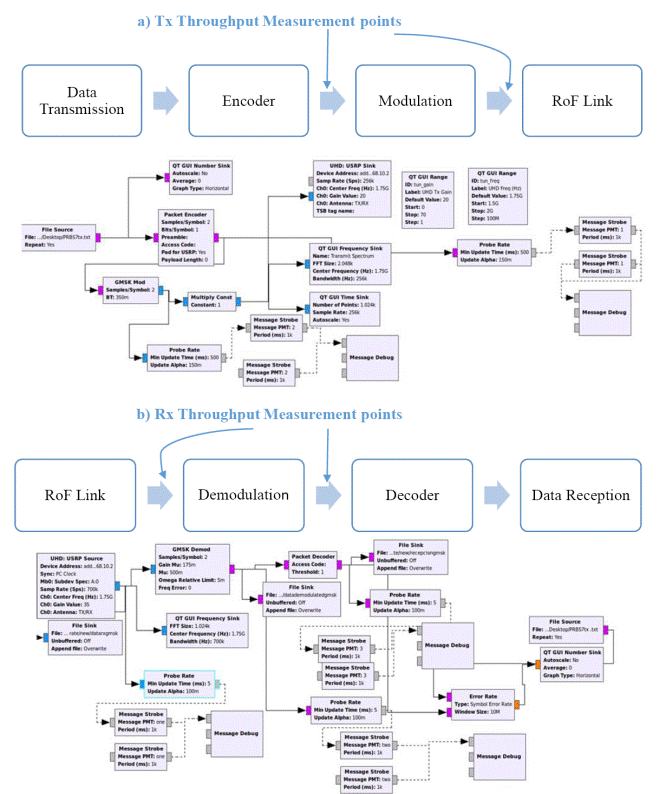
Figure 1 Block Diagram in GNU Radio to measure latency a) Transmission Flow Graph in GNU Radio and Throughput measurement points b) Reception Flow Graph in GNU Radio and Throughput measurement points
In each flow graph of GNU Radio, it is possible to control all the USRP software-defined parameters, such as transmitted power, gain, frequency, antenna selection, etc. For this experiment, we set a gain of 20 dB in the transmitter as well as in the receiver. Likewise, we set the Tx/Rx port for transmission and Rx port for the reception.
In the modulation block, parameters as the sampling frequency and the number of bits per symbol are established, to obtain three data rates of 200, 500 and 700 kbps. 2 samples per symbol were fixed to obtain these 3 different data rates. Those data rates were considered due to the subsequent PING validation, in order to prove the methodology to measure latency using SDR. After the modulation block, data are sent through the USRP to the Radio-over-Fiber link (The RoF Link will be described in the next section). At the reception, data are received through the USRP, demodulated and decoded. Then, a file sink is used to print the PRBS7 sequence. GNU Radio provides blocks for packet encoder and decoder as well as modulation and demodulation.
In order to measure the latency, 4 points to measure throughput were established as Figure 1 shows, by means of the GNU radio block 'probe rate' presented in our previous work [17]. In that paper, we presented a new procedure to measure real time latency in hybrid optical‐wireless links. In the present article, we use the same setup as before, this time focusing on the analysis of modulation, bit error rate and latency.
Throughput measurement indicates the amount of data that passes through the connection over a time period [18]. The throughput is a measure that has been taken into account to characterize the performance of the links. For example in [19], author used the throughput as a network performance metric that gives the actual data rate of a specific application [19]. In this way the measurements of latency consider the packet size and the throughput that gives GNU Radio, in each point. The sum of all measurement points is established as the end-to-end latency.
3. W-band radio over fiber setup
In this experimental setup, we set a Radio-over-fiber link in the 75-100 GHz band, specifically at 86 GHz. Usually, a RoF link is composed of three stages, central office, base station and wireless receiver. In the central Office, the radio frequency signal is modulated with the optical signal. The millimeter wave signal generated from the separation of the two optical tones is transported through an optical fiber to the base station. In the base station, the optical signal is turned to the electrical domain, amplified and transmitted to the free space. In the wireless receiver, the signal is amplified and adapted to the final user.
Figure 2 shows the experimental setup. In the central Office, the output of a 1550 nm external cavity laser (ECL), with an output power of 12.43 dBm, is used as input to a Mach-Zehnder modulator (MZM). By driving the modulator with a pure sinusoidal tone of 43 GHz, generated by a vector signal generator (VSG), the second harmonic of this tone is obtained at the output of the MZM. Therefore, the generation of two optical signals with a separation of 86 GHz is achieved. An erbium doped fiber amplifier (EDFA) is used to amplify the signal, and an arrayed waveguide grating (AWGG) separates the two optical lines to enable the modulation of one of them by means of a second MZM. The data signal to modulate the second MZM is generated by a USRP transceiver through GNU Radio software defined radio. One of the two optical signals is modulated with the data signal. The other optical tone is connected to a variable optical attenuator (VOA) to set equal power in both the unmodulated and modulated optical signals and an optical coupler combines them. A second EDFA and a second VOA are employed to set the launch power into the 6 km SMF.
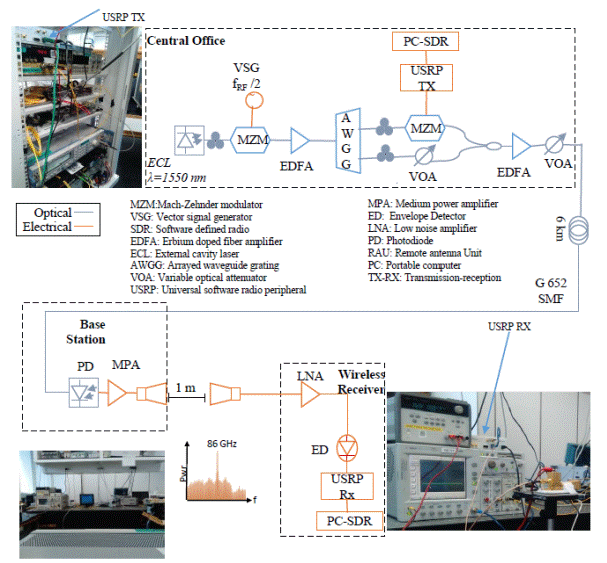
Figure 2 W-Band Hybrid Fiber-Wireless Setup, blue line means optical domain and red line means electrical domain
After fiber transmission, in the base station, a high speed broadband photodiode (PD) (Finisar XPDV4120R) with a 3 dB bandwidth of 90 GHz, converts the optical signal to the electrical domain, where the signal is boosted by a 12 dB medium power amplifier (MPA) before wireless transmission over 100 cm.
A pair of horn antennas is used for wireless transmission, each one with 24 dB gain. At the wireless receiver, the transmitted signal is amplified by a 40 dB low noise amplifier (LNA). A Schottky diode based W-Band envelope detector (ED) is used to down-convert the data signal to the original intermediate frequency (IF) generated by the USRP. The IF signal is sent to the receiver USRP and a PC software defined radio application is used to demodulate, storage and analyze the transmitted signals. Offline digital signal processing (DSP) is used to compute the BERs.
4. Latency measurement results
As mentioned previously, the latency is made up of four components: propagation time, transmission time, queuing time and processing delay. End-to-end latency is the sum of all these four components. In the setup, the propagation time through 6 km of single mode optical fiber was 29.38 µs theoretical and 28.5 µs in practice. The transmission time depends on the message size, in this case, our message is a pseudo-random binary sequence (PRBS7) which was sent repeatedly through GNU Radio. In addition, the SDR was in charge of making packages of 64 bytes. The processing delay depends on the USRP N210 and comprises the WBX daughterboard and the FPGA motherboard. The last delay is the queuing time, which depends on the USRP buffers size and interrupts coalescence at the Network Interface Card NIC layer parameter. The value of the buffer size of the USRP was set by default.
In this work, we made three important analyses. First, we developed a procedure to measure latency using GNU Radio and compared different modulation blocks as GMSK, DQPSK, 8PSK, QAM16. The time obtained was verified with a later PING validation. Figure 3 shows the real time W band RoF latency measurements with the modulation techniques mentioned and the three different data rates. The blue line in the figure represents the first data rate considered, orange line the second and gray line the third data rate measured.
As the modulation format advances in terms of number of bits per symbol processed and the data rate is high, the latency is lower. We reached end to end latency of about 2 ms using software defined radio. If the data rate is high, an end to end latency of 1 ms that 5G networks require can be achieved.
Secondly, two scenarios were analyzed in order to compare the time difference between the SDR system (Back-to-Back) and the hybrid fiber-wireless system. One of these scenarios only tested two USRP with the wireless transmission and the other included all the W-band radio-over-fiber setup.
Figure 4 shows the real time achieved back-to-back in the wireless scenario against latency measurements of W-Band radio over fiber link.
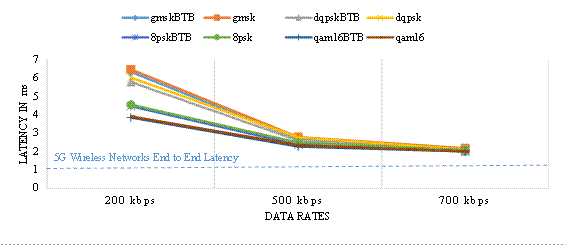
Figure 4 Real time latency measurements Back to back wireless scenario Vs W-Band radio over fiber link for differents modulation techniques
The results show that the difference between back-to-back latency measurements with the radio-over-fiber link is around 100 µs on average.
Finally, we used an offline DSP to evaluate the Bit Error Rate. Figure 5 describes the BER measurements for different modulation formats and data rates analyzed. The results of this evaluation show that modulation schemes with less processed bits per symbol achieved error free data.
Modulations techniques such as 8PSK and 16QAM resulted in bit error rates between the 7% and 20% Forward Error Correction (FEC) Limit BER accepted. Moreover, when the optical power on the PD of the transmitter is weak, the USRP at the reception is not able to store all transmitted data. When the modulation format order is high with respect to the number of processed bits per symbol, less PRBS arrived completely.
5. Conclusions
Taking into account the reliability of the results and the validity of the data obtained, three different analyses were performed. The first analysis tested the method for measuring latency in an experimental setup. This is important since there is no evidence in the literature of practical developments to measure latency at the physical layer. Most authors measure latency through the medium Access Control (MAC) network layer. Additionally, 2 ms of latency were achieved on a radio-over-fiber link, which brings us closer to 5G end-to end latency standard. The results achieved show feasibility of meeting the stringent 5G wireless networks requirements of very low latency, and lay the basis for further research that require high precision in end-to-end latency measurements.
The second analysis evaluated both the Radio-over-Fiber link and the wireless link. An in-depth latency analysis was carried out in W-Band fiber-wireless link using software defined radio. SDR allows simplifying the radio equipment and replacing them with a software that is capable of performing complex functions. The difference between a single radio link and the hybrid link is only 100 microseconds, which means that it is possible to use hybrid networks in 5G systems. This allows greater transmission capacity without affecting latency. In addition, the introduction of GNU Radio and USRP combines the capabilities of fiber-wireless systems with the software defined radio potential.
Finally, data received were validated to test reliability by digital offline processing. On average 500 PRBS were correctly received for each modulation scheme proposed. In most of modulation schemes evaluated, error-free data was obtained.













